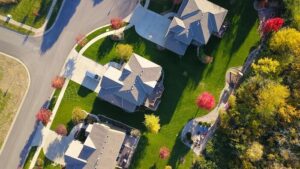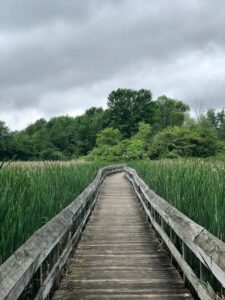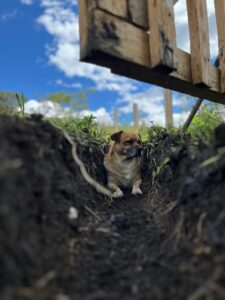The Connection Between Native Gardening and Mental Health
Native plant gardening is not something I chose or set out to do. That is, until I learned about it, and then there was no question as to how I would move forward. I was a “normal” gardener. I bought plants for my yard at big box stores  near my house, based on colors of blooms, length of bloom, how the plants would look in my garden, etc. Plants from nearby stores obviously belong in yards, right?!
near my house, based on colors of blooms, length of bloom, how the plants would look in my garden, etc. Plants from nearby stores obviously belong in yards, right?!
But then I read an article that called all of my plants “invasive,” “introduced,” and “nonnative.” So I had to dig deeper, as these words felt misaligned with my preferred existence in the world. My research taught me that introduced plants are native to another part of the world, but they were never naturally occurring here. Because these plants do not naturally grow here, they are not as beneficial to insects, birds, wildlife and the local environment as native plants are. They can also do extensive damage to local ecosystems.
And that did it for me. I know that our planet has struggled with different challenges in my lifetime and my parents’ lifetimes. I also know that these problems change over time (largely in response, now, to human behavior). And there are now some major environmental problems that we face today. My reading taught me that my yard can fight against some of the biggest environmental challenges of our time: biodiversity loss, air pollution/carbon cycle instability, soil degradation and water insecurity (see the 15 biggest environmental problems of 2025 here). How native plants fight against these challenges will have to be written about another time. For today, please reference Doug Tallamy (see below for link) and Benjamin Vogt’s articles, books, social media accounts and online trainings.

Image descriptor: Native cattails do not grow this thick. These are introduced/hybridized cattails that invade entire lakes, marshes and shorelines in the United States (Bansal, 2020).
Because I want my yard to fight against and not contribute to major environmental problems of today, I have completely changed my yard and how I garden. An added perk is that my yard attracts more beautiful insects and birds than most homes near me. And now gardening is not just a hobby of mine; gardening is my act of resistance and it fuels my hope for the future. And that is how this blog turns into a mental health and wellness blog. It’s really a discussion about how native gardening helps to keep me (and many people that I know) hopeful and well.
How Does Gardening Benefit Mental Health?
As a mental health therapist, I assess mental wellness by examining the following domains in a person’s life: Physical, mental/psychological, social, emotional and spiritual. Beyond these areas, I look at whether or not people can handle stressors successfully; can they adapt during times of stress?
And this is where native gardening comes in.
Physical Benefits: More Than Just Exercise
If a person is out gardening, they are obviously moving around to some degree. There are many types of movement that naturally need to happen when native gardening. To pull from author and biomechanist Katy Bowman’s work, native gardening is a great way to “stack” different movement needs humans have into one activity (possibly with kids, neighbors, partners or friends, also). Between walking around to get set up, digging to plant, moving dirt around and reaching for tools… a lot of movement is happening! Additionally, most new native plant gardeners do not understand native plant sociability (myself very much included) so after a year or two of native gardening, the amount of digging up plants that are “bossy” is also very extensive (more so than with “traditional”/introduced gardening). I am at a particularly interesting crossroad at this point, as I am 7 years into native gardening today… which means that I am digging up major, rhizomatic root systems/plants CONSTANTLY. I walk, tug, pull, lift, walk more, squat and dig endlessly.
movement that naturally need to happen when native gardening. To pull from author and biomechanist Katy Bowman’s work, native gardening is a great way to “stack” different movement needs humans have into one activity (possibly with kids, neighbors, partners or friends, also). Between walking around to get set up, digging to plant, moving dirt around and reaching for tools… a lot of movement is happening! Additionally, most new native plant gardeners do not understand native plant sociability (myself very much included) so after a year or two of native gardening, the amount of digging up plants that are “bossy” is also very extensive (more so than with “traditional”/introduced gardening). I am at a particularly interesting crossroad at this point, as I am 7 years into native gardening today… which means that I am digging up major, rhizomatic root systems/plants CONSTANTLY. I walk, tug, pull, lift, walk more, squat and dig endlessly.
For people who do not love traditional exercise, native gardening can be a good substitute in order to get movement needs met, especially if the gardener is motivated by fighting against environmental problems that we face today (or if they are inspired by beautiful butterflies and birds). I know these both fuel me when I am out working in the yard and am tired. I do know that the bugs, birds, animals and environment will be better off if my plants are planted, rooted, growing and replenishing the soil. And so… I am able to keep going, which also helps me fight the sedentarism that exists and is accepted in our culture (reference Katy Bowman’s work to read more about sedentarism). Additionally, all types of gardening can be more accessible than traditional exercise for people with movement limitations.
Psychological Benefits: A Natural Stress Reducer
Research has confirmed for many years that gardening (of all types) leads to a decrease in mental health symptoms (ClinMed, 2018). People being outdoors in greenspace has endless positive impacts for mental health. There is a lot of research about the positive benefit of gardening for people’s mental health, but I believe this is truer today than ever before (at least in the past 75 years) because of the amount of Ecoanxiety that people are currently experiencing. A global survey in 2021 showed that more than 50% of young adults ages 16-25 felt sad, angry, anxious or experienced other negative emotions about the current state of the Earth. These feelings are now called “Ecoanxiety,” which can be defined as a “chronic fear of environmental doom” (Pearson, 2024).
symptoms (ClinMed, 2018). People being outdoors in greenspace has endless positive impacts for mental health. There is a lot of research about the positive benefit of gardening for people’s mental health, but I believe this is truer today than ever before (at least in the past 75 years) because of the amount of Ecoanxiety that people are currently experiencing. A global survey in 2021 showed that more than 50% of young adults ages 16-25 felt sad, angry, anxious or experienced other negative emotions about the current state of the Earth. These feelings are now called “Ecoanxiety,” which can be defined as a “chronic fear of environmental doom” (Pearson, 2024).
So… the research still exists about all of the reasons that gardening is beneficial to the human psyche. I won’t list all of that here, as you can look that up online and get thousands of articles in seconds. But native gardening hits differently. Not only are people outside, in nature, in greenspace, breathing outdoor air (I want to say “fresh air,” but…), moving their bodies, engaging in a multisensory experience, but they are also fighting against the environmental stressors that create Ecoanxiety in most of us every day.
For me, I also feel hope when I garden with native plants. I hope that the beneficial insects can thrive in my yard, that the birds can find dinner in my yard, and that the soil in my yard is stable, healthy and prevents erosion/fight against major water events. My yard is a small habitat for those who were here before us; for those who provide us with honey and vegetables, for those who fill our outdoor spaces with beautiful song. I am driven to help them live their lives and to share that if others also do so, we might slow the extinction of insects and animals that are currently disappearing because of habitat loss, pollution/insecticides, urban sprawl, a warming planet and 3,000 other environmental reasons (Gajbhiye, 2025). I know that my yard is safe for these very important beings.
Social Benefits: Growing Community
Native plant people have a vibe. We’re at the plant sales only shopping in native plant areas, and we are happy to be around each other. We are united by the fact that we are all planting for the future; we are planting for the threatened insects and animals and we are planting to help curb “natural disasters” and weather events. We enjoy looking for plants at the sales, but we’re on a mission. We know the threats the Earth is under at this time and we hope that our yards can make a positive impact. With this in mind, we chat. We talk native plants, and we share information about native plants with anyone who will listen. We are a community and we feel understood when we’re together. We belong because we are united to fight together.
All types of gardening increase sociability in humans simply by getting people outside. Being outside might result in a shared conversation with an unknown neighbor or other passersbys. Plant people like to talk about plants, problems they’re having in the garden, and pretty blooms. All of this helps people to socialize more, which we know helps people maintain cognitive skills and slow cognitive decline with aging (Freeman, 2017). We are living during a time when the “loneliness epidemic” is a common term and humans report being lonelier than ever before in recorded history, and gardens easily fight against this. As a species, we are in community more when we grow things outdoors. 
We all know that our planet is hurting in a big way right now. We read about this and hear about this constantly. And most of us feel that there is little that we can do, as we are just one person on a planet of 8.2 billion people. But some of us have found hope in native gardening. We use our yards to fight against what has become normal in America: too much grass, annual mulch application, endless chemicals, introduced plants that harm native plants and wildlife. And we hope what we’re doing will help. We meet one another and we learn that there are others who are doing what we’re doing. We become friends who fight against a hurtful cultural norm together. We attend plant sales and feel great joy when the native plants are sold out, as we know that means there are a growing number of us who see that we can restore that which has been profoundly disrupted in the United States: the native landscape that was once healthy and thriving. So we keep planting and talking to passerbys. And we hope to see some of the people we met in our yard at the next native plant sale.
For more information as to how to get started, even on your apartment balcony, please visit Dough Tallamy’s Homegrown National Park website: www.homegrownnationalpark.org
Blog written by Sentier therapist and clinic owner, Megan Sigmon-Olsen, MSW, LICSW.
Sources
Bansal, S. (2020, May 30). Cattail (Typha) invasion in North American wetlands. United States Geological Survey. Retrieved June 1, 2025, from https://www.usgs.gov/news/cattail-typha-invasion-north-american-wetlands#:~:text=In%20the%20U.S.%2C%20invasion%20of%20cattail%20has,targeted%20physical%2C%20chemical%2C%20and%20hydrologic%20management%20efforts.
Bowman, K. (n.d.). The Problem: We Are Not Moving Enough. Nutritiousmovement.com. Retrieved May 11, 2025, from https://www.nutritiousmovement.com/about-nutritious-movement
Clin Med (Lond). 2018 Jun;18(3):201–205. doi: 10.7861/clinmedicine.18-3-201
Gajbhiye, S. (2025, April 23). Insects are still disappearing – and there are hundreds of reasons why. Earth.com. https://www.earth.com/news/insects-are-still-disappearing-and-there-are-hundreds-of-reasons-why/
Pearson, H. (2024). The rise of eco-anxiety: scientists wake up to the mental-health toll of climate change. Nature, 628(8007), 256–258. https://doi.org/10.1038/d41586-024-00998-6
Social connections lead to longevity, especially in seniors. (2017). Blue Zones. https://www.bluezones.com/news/social-connections-longevity-seniors/
Freeman, L. (2017, March). Mental fitness: Study shows seniors stay healthier with social connections. Naples Daily News; Naples Daily News. Retrieved May 15, 2025 from https://www.naplesnews.com/story/news/2017/03/01/mental-fitness-study-shows-seniors-stay-healthier-social-connections/98520962/





